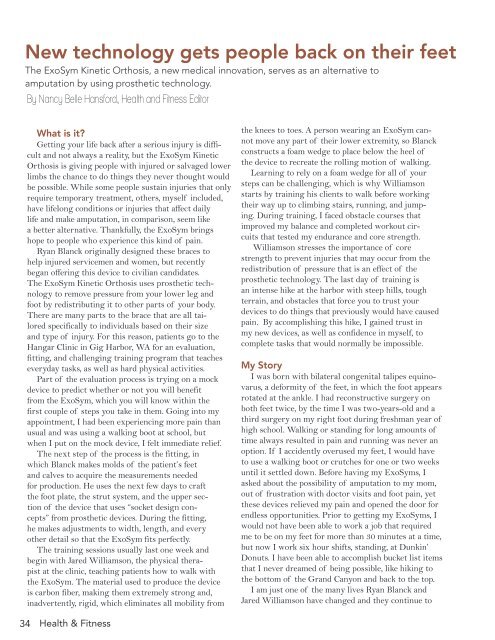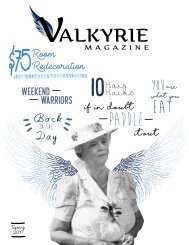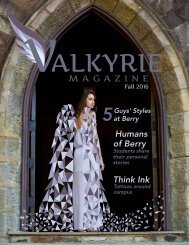Valkyrie Fall 2018 - Issue 1
Create successful ePaper yourself
Turn your PDF publications into a flip-book with our unique Google optimized e-Paper software.
New technology gets people back on their feet<br />
The ExoSym Kinetic Orthosis, a new medical innovation, serves as an alternative to<br />
amputation by using prosthetic technology.<br />
By Nancy Belle Hansford, Health and Fitness Editor<br />
What is it?<br />
Getting your life back after a serious injury is difficult<br />
and not always a reality, but the ExoSym Kinetic<br />
Orthosis is giving people with injured or salvaged lower<br />
limbs the chance to do things they never thought would<br />
be possible. While some people sustain injuries that only<br />
require temporary treatment, others, myself included,<br />
have lifelong conditions or injuries that affect daily<br />
life and make amputation, in comparison, seem like<br />
a better alternative. Thankfully, the ExoSym brings<br />
hope to people who experience this kind of pain.<br />
Ryan Blanck originally designed these braces to<br />
help injured servicemen and women, but recently<br />
began offering this device to civilian candidates.<br />
The ExoSym Kinetic Orthosis uses prosthetic technology<br />
to remove pressure from your lower leg and<br />
foot by redistributing it to other parts of your body.<br />
There are many parts to the brace that are all tailored<br />
specifically to individuals based on their size<br />
and type of injury. For this reason, patients go to the<br />
Hangar Clinic in Gig Harbor, WA for an evaluation,<br />
fitting, and challenging training program that teaches<br />
everyday tasks, as well as hard physical activities.<br />
Part of the evaluation process is trying on a mock<br />
device to predict whether or not you will benefit<br />
from the ExoSym, which you will know within the<br />
first couple of steps you take in them. Going into my<br />
appointment, I had been experiencing more pain than<br />
usual and was using a walking boot at school, but<br />
when I put on the mock device, I felt immediate relief.<br />
The next step of the process is the fitting, in<br />
which Blanck makes molds of the patient’s feet<br />
and calves to acquire the measurements needed<br />
for production. He uses the next few days to craft<br />
the foot plate, the strut system, and the upper section<br />
of the device that uses “socket design concepts”<br />
from prosthetic devices. During the fitting,<br />
he makes adjustments to width, length, and every<br />
other detail so that the ExoSym fits perfectly.<br />
The training sessions usually last one week and<br />
begin with Jared Williamson, the physical therapist<br />
at the clinic, teaching patients how to walk with<br />
the ExoSym. The material used to produce the device<br />
is carbon fiber, making them extremely strong and,<br />
inadvertently, rigid, which eliminates all mobility from<br />
the knees to toes. A person wearing an ExoSym cannot<br />
move any part of their lower extremity, so Blanck<br />
constructs a foam wedge to place below the heel of<br />
the device to recreate the rolling motion of walking.<br />
Learning to rely on a foam wedge for all of your<br />
steps can be challenging, which is why Williamson<br />
starts by training his clients to walk before working<br />
their way up to climbing stairs, running, and jumping.<br />
During training, I faced obstacle courses that<br />
improved my balance and completed workout circuits<br />
that tested my endurance and core strength.<br />
Williamson stresses the importance of core<br />
strength to prevent injuries that may occur from the<br />
redistribution of pressure that is an effect of the<br />
prosthetic technology. The last day of training is<br />
an intense hike at the harbor with steep hills, tough<br />
terrain, and obstacles that force you to trust your<br />
devices to do things that previously would have caused<br />
pain. By accomplishing this hike, I gained trust in<br />
my new devices, as well as confidence in myself, to<br />
complete tasks that would normally be impossible.<br />
My Story<br />
I was born with bilateral congenital talipes equinovarus,<br />
a deformity of the feet, in which the foot appears<br />
rotated at the ankle. I had reconstructive surgery on<br />
both feet twice, by the time I was two-years-old and a<br />
third surgery on my right foot during freshman year of<br />
high school. Walking or standing for long amounts of<br />
time always resulted in pain and running was never an<br />
option. If I accidently overused my feet, I would have<br />
to use a walking boot or crutches for one or two weeks<br />
until it settled down. Before having my ExoSyms, I<br />
asked about the possibility of amputation to my mom,<br />
out of frustration with doctor visits and foot pain, yet<br />
these devices relieved my pain and opened the door for<br />
endless opportunities. Prior to getting my ExoSyms, I<br />
would not have been able to work a job that required<br />
me to be on my feet for more than 30 minutes at a time,<br />
but now I work six hour shifts, standing, at Dunkin’<br />
Donuts. I have been able to accomplish bucket list items<br />
that I never dreamed of being possible, like hiking to<br />
the bottom of the Grand Canyon and back to the top.<br />
I am just one of the many lives Ryan Blanck and<br />
Jared Williamson have changed and they continue to<br />
help people every day with these incredible devices. Beth<br />
Shaver, the second civilian to receive the ExoSym, was<br />
injured in a soccer game at the age of 23 and complications<br />
from her multiple surgeries left her with severe<br />
pain. She lost her ability to walk and began considering<br />
amputation. “I am blessed every day for how the Exo-<br />
Sym has changed my life,” said Shaver. She went from not<br />
being able to walk to completing a 120-mile adventure<br />
race in 2014, just one year after receiving her device.<br />
Shaver is an inspiration to many people,<br />
myself included, as she tells her story via her<br />
blog “Exosymplyamazing,” which serves as a platform<br />
to educate and motivate people with the device.<br />
She shares tips and tricks on fashion and footwear<br />
with the device, as well as personal stories to motivate<br />
people to stay positive and reach their goals.<br />
While I was in Washington for my initial fitting,<br />
I was lucky enough to meet Shaver and many other<br />
incredible people who have experienced the miracle of<br />
the ExoSym. Hearing stories from fellow patients gave<br />
me perspective on the hardships other people face every<br />
Photos by Madison Morris, Asst. Photo Editor<br />
day and made me proud to be an owner of my devices.<br />
I get excited every time someone asks about my device<br />
because it gives me the opportunity to spread awareness<br />
of the ExoSym. If my mom had not spent hours<br />
researching on the computer, I would not have my Exo-<br />
Syms, which have given me the opportunity to train in<br />
Washington alongside very inspiring patients, reach<br />
goals previously unrealistic, and not have to have more<br />
surgeries in the future. I aim to spread awareness so<br />
that people, like Shaver and myself, can find the Exo-<br />
Sym and start the process of getting their life back.<br />
34 Health & Fitness<br />
35














